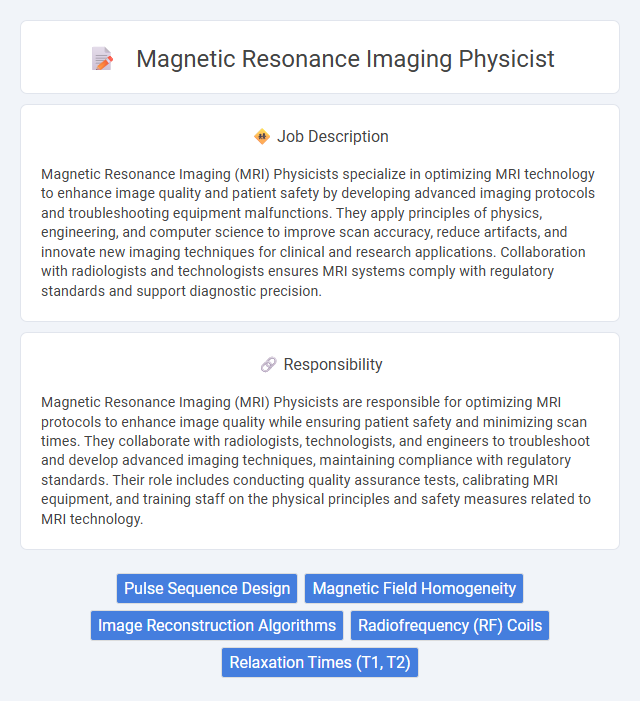
Magnetic Resonance Imaging (MRI) Physicists specialize in optimizing MRI technology to enhance image quality and patient safety by developing advanced imaging protocols and troubleshooting equipment malfunctions. They apply principles of physics, engineering, and computer science to improve scan accuracy, reduce artifacts, and innovate new imaging techniques for clinical and research applications. Collaboration with radiologists and technologists ensures MRI systems comply with regulatory standards and support diagnostic precision.
Individuals with strong analytical skills and a background in physics are likely well-suited for a Magnetic Resonance Imaging (MRI) Physicist position, given the technical and problem-solving nature of the role. Those who possess patience and attention to detail may thrive in managing MRI system performance and ensuring image quality. People who prefer hands-on work with advanced medical technology and enjoy collaborating with healthcare professionals might find this career particularly fitting.
Qualification
Magnetic Resonance Imaging Physicists typically hold a master's or doctoral degree in medical physics, biomedical engineering, or a related field, with specialized training in MRI technology and safety protocols. Certification from recognized bodies such as the American Board of Radiology or equivalent international organizations is often required to demonstrate expertise in MRI physics and quality assurance. Strong analytical skills, experience with MRI system calibration, and knowledge of magnetic field interactions are essential qualifications for ensuring high-quality imaging and patient safety.
Responsibility
Magnetic Resonance Imaging (MRI) Physicists are responsible for optimizing MRI protocols to enhance image quality while ensuring patient safety and minimizing scan times. They collaborate with radiologists, technologists, and engineers to troubleshoot and develop advanced imaging techniques, maintaining compliance with regulatory standards. Their role includes conducting quality assurance tests, calibrating MRI equipment, and training staff on the physical principles and safety measures related to MRI technology.
Benefit
Magnetic Resonance Imaging (MRI) Physicists probably enjoy a range of benefits, including opportunities to work with cutting-edge imaging technology that enhances diagnostic accuracy. The role likely offers the potential for professional growth through collaboration with medical teams and involvement in research projects. Competitive salaries and a stable job market in healthcare settings are expected advantages of this specialized career.
Challenge
A Magnetic Resonance Imaging (MRI) Physicist likely faces complex challenges in optimizing image quality while ensuring patient safety through precise calibration of MRI systems. Balancing the integration of advanced imaging techniques with ever-evolving technological standards may require continuous problem-solving and adaptation to diverse clinical needs. This role probably demands a strong understanding of physics principles and collaborative skills to troubleshoot hardware and software issues effectively.
Career Advancement
Magnetic Resonance Imaging (MRI) Physicists play a critical role in optimizing MRI technology, ensuring image quality, and improving diagnostic accuracy. Career advancement opportunities typically include leading research projects, specializing in advanced imaging techniques, and transitioning into managerial roles overseeing imaging departments. Continuous education and certification, such as obtaining board certification in MRI physics, significantly enhance prospects for elevated positions and influence within healthcare institutions.
Key Terms
Pulse Sequence Design
A Magnetic Resonance Imaging (MRI) Physicist specializing in Pulse Sequence Design develops and optimizes complex MRI pulse sequences to improve image quality and diagnostic accuracy. Expertise in radiofrequency pulses, gradient waveforms, and timing parameters enables enhancement of tissue contrast, spatial resolution, and scan efficiency. Proficiency in MRI hardware, software programming, and physics principles is essential to innovate non-invasive imaging techniques for clinical and research applications.
Magnetic Field Homogeneity
Magnetic Resonance Imaging Physicists specialize in optimizing magnetic field homogeneity to enhance image quality and diagnostic accuracy. They employ advanced shimming techniques and field mapping to correct inhomogeneities in the main magnetic field, ensuring consistent resonance frequencies across the imaging volume. Precise control of magnetic field uniformity is critical for artifact reduction and reliable quantitative measurements in clinical MRI applications.
Image Reconstruction Algorithms
Magnetic Resonance Imaging Physicists specialize in developing and optimizing image reconstruction algorithms to enhance MRI scan quality and diagnostic accuracy. Expertise in Fourier transform techniques, compressed sensing, and parallel imaging methods is critical for improving signal-to-noise ratio and spatial resolution. Proficiency in programming languages such as MATLAB, Python, and C++ supports the implementation and validation of advanced reconstruction algorithms tailored to clinical and research applications.
Radiofrequency (RF) Coils
Magnetic Resonance Imaging Physicists specializing in Radiofrequency (RF) Coils design and optimize coil configurations to enhance signal-to-noise ratio and image resolution in MRI systems. They conduct electromagnetic simulations and experimental validations to improve coil sensitivity, uniformity, and patient safety during scans. Expertise in RF coil engineering directly influences the quality of diagnostic imaging and the development of advanced MRI technologies.
Relaxation Times (T1, T2)
Magnetic Resonance Imaging (MRI) Physicists specialize in optimizing relaxation times, specifically T1 and T2, to enhance image contrast and diagnostic accuracy. Understanding tissue-specific T1 and T2 values allows these experts to tailor pulse sequences and improve signal-to-noise ratio, essential for precise anatomical and pathological characterization. Expertise in manipulating relaxation parameters directly impacts the development of advanced MRI techniques and quantitative imaging biomarkers.
 kuljobs.com
kuljobs.com